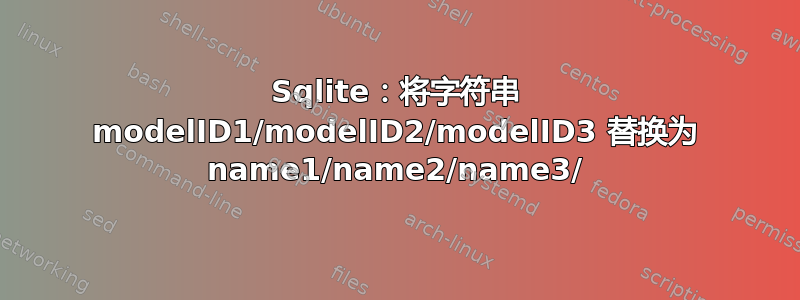
我的目标是读取 macOS Photos.app 数据库以找出所包含照片的路径。相册及其父文件夹的名称为RK文件夹可以为每张照片确定表格。该父文件夹可以位于其他文件夹中。也可以读出生成的文件夹路径...但采用以下形式:
modelId 1/modelID 2/modelId 3/modelID 4
在这里我不能再进一步,因为我没有足够的知识来用真实的文件夹名称替换字符串。对于可能的解决方案,应该注意的是,我使用数据库的副本,因此文件夹路径也可以直接写入 RKFolder 表中。
SELECT
modelId, name,folderPath, uuid
FROM RKFolder
WHERE implicitAlbumUuid not NULL
结果(摘录)
modelId name folderPath uuid
1 1/ LibraryFolder
2 TopLevelAlbums 1/2/ TopLevelAlbums
7 Test 1/2/7/ kbY7RDHjRLS
8 xxx 1/2/8/ bT5WAkPWQ1
9 Test 1/2/8/9/ 9PYeLZDRTne
10 ab 1/2/10/ 7Cse21+1SIag
11 abc 1/2/7/11/ pNMvzDdyS%
16 efg 1/2/7/11/16/ a6R97tAxSBW
像这样替换:
modelId name folderPath uuid
1 / LibraryFolder
2 TopLevelAlbums /TopLevelAlbums/ TopLevelAlbums
7 Test /TopLevelAlbums/Test/ kbY7RDHjRLS
8 xxx /TopLevelAlbums/xxx/ bT5WAkPWQ1
9 Test /TopLevelAlbums/xxx/Test/ 9PYeLZDRTne
10 ab /TopLevelAlbums/ab/ 7Cse21+1SIag
11 abc /TopLevelAlbums/Test/abc/ pNMvzDdyS%
16 efg /TopLevelAlbums/Test/abc/efg/ a6R97tAxSBW
或者如果没有 TopLevelAlbums-main 文件夹就更好了:
modelId name folderPath uuid
16 efg /Test/abc/efg/ a6R97tAxSBW
这是我到目前为止使用的脚本(缩短):
SELECT
RKAlbumVersion.versionId,
RKVersion.filename,
(SELECT RKFolder.folderpath from RKFolder, RKAlbum
WHERE RKFolder.uuid = RKAlbum.folderUuid
and RKAlbum.modelID = RKAlbumVersion.albumId)
FROM RKMaster, RKAlbumVersion, RKVersion
WHERE RKVersion.modelId = RKAlbumVersion.versionId
and RKVersion.masterUuid = RKMaster.uuid
-->
Output:
77 001.JPG 1/2/7/11/16/
replace with:
77 001.JPG /Test/abc/efg/
答案1
你可以用 perl 来做到这一点:
#!/usr/bin/perl
# number of parent directories to drop
$drop = 2;
open( $input, '<', $ARGV[0] );
# drop header lines
$line = <$input>;
$line = <$input>;
# third line is first data, being root has no name, was requested that it wasn't used, which is good, because it makes life simplier, assuming the first dir is always 1
$line = <$input>;
#@databits = split(/\s+/, $line);
$hash{'1'} = '';
while ( $line = <$input> ) {
@databits = split(/\s+/, $line);
$hash["$databits[0]"] = $databits[1];
}
close( $input );
open( $input, '<', $ARGV[0] );
# now we print!
# headers
$line = <$input>;
print "$line";
$line = <$input>;
print "$line";
# drop first data line
$line = <$input>;
while ( $line = <$input> ) {
@databits = split(/\s+/, $line);
@replace = split(/\//, $databits[2]);
$count = 0; # start at the start
foreach (@replace) {
$replace[$count] = $hash[$_];
$count++;
}
for (my $i=0; $i < $drop; $i++) {
shift(@replace);
}
$replaced = join('/', @replace);
if ( $replaced ne '' ) {
print "$databits[0] $databits[1] /$replaced/ $databits[3]\n";
}
}
将输出作为文本文件输入,在下面的示例中名为“input”。您可以使用 column 命令制作漂亮的列。
$ ./replace.pl input | column -t
modelId name folderPath uuid
7 Test /Test/ kbY7RDHjRLS
8 xxx /xxx/ bT5WAkPWQ1
9 Test /xxx/Test/ 9PYeLZDRTne
10 ab /ab/ 7Cse21+1SIag
11 abc /Test/abc/ pNMvzDdyS%
16 efg /Test/abc/efg/ a6R97tAxSBW


